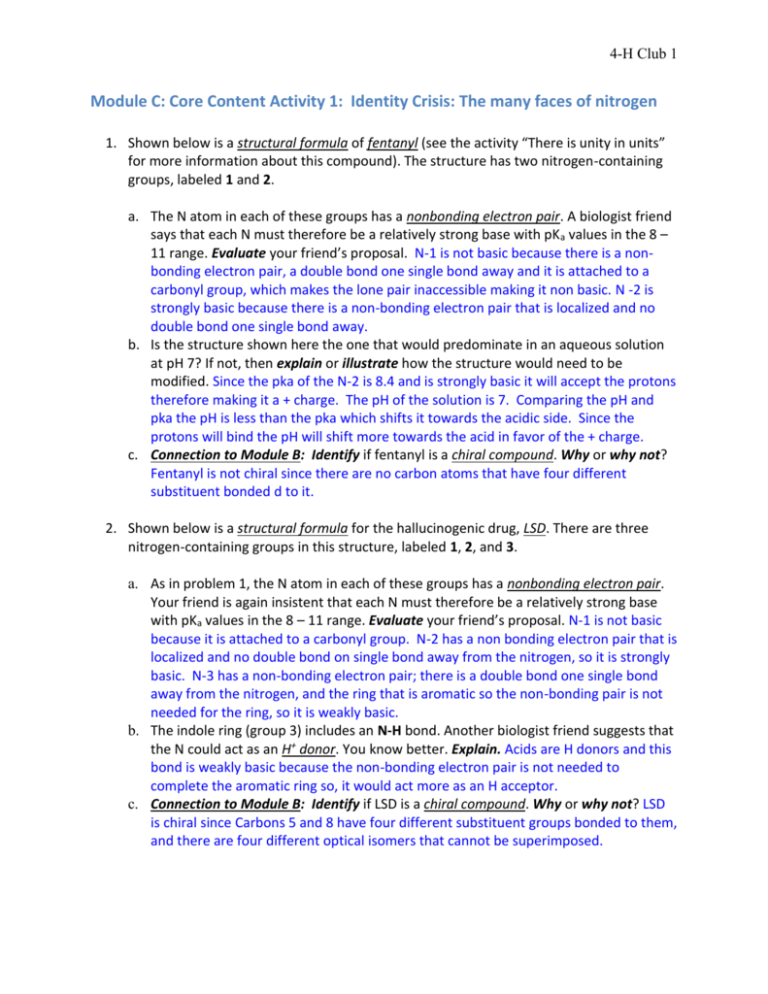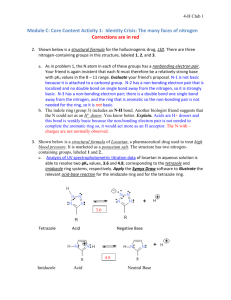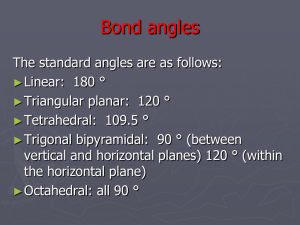Module C: Core Content Activity 1: Identity Crisis: The
advertisement

4-H Club 1 Module C: Core Content Activity 1: Identity Crisis: The many faces of nitrogen 1. Shown below is a structural formula of fentanyl (see the activity “There is unity in units” for more information about this compound). The structure has two nitrogen-containing groups, labeled 1 and 2. a. The N atom in each of these groups has a nonbonding electron pair. A biologist friend says that each N must therefore be a relatively strong base with pKa values in the 8 – 11 range. Evaluate your friend’s proposal. N-1 is not basic because there is a nonbonding electron pair, a double bond one single bond away and it is attached to a carbonyl group, which makes the lone pair inaccessible making it non basic. N -2 is strongly basic because there is a non-bonding electron pair that is localized and no double bond one single bond away. b. Is the structure shown here the one that would predominate in an aqueous solution at pH 7? If not, then explain or illustrate how the structure would need to be modified. Since the pka of the N-2 is 8.4 and is strongly basic it will accept the protons therefore making it a + charge. The pH of the solution is 7. Comparing the pH and pka the pH is less than the pka which shifts it towards the acidic side. Since the protons will bind the pH will shift more towards the acid in favor of the + charge. c. Connection to Module B: Identify if fentanyl is a chiral compound. Why or why not? Fentanyl is not chiral since there are no carbon atoms that have four different substituent bonded d to it. 2. Shown below is a structural formula for the hallucinogenic drug, LSD. There are three nitrogen-containing groups in this structure, labeled 1, 2, and 3. a. As in problem 1, the N atom in each of these groups has a nonbonding electron pair. Your friend is again insistent that each N must therefore be a relatively strong base with pKa values in the 8 – 11 range. Evaluate your friend’s proposal. N-1 is not basic because it is attached to a carbonyl group. N-2 has a non bonding electron pair that is localized and no double bond on single bond away from the nitrogen, so it is strongly basic. N-3 has a non-bonding electron pair; there is a double bond one single bond away from the nitrogen, and the ring that is aromatic so the non-bonding pair is not needed for the ring, so it is weakly basic. b. The indole ring (group 3) includes an N-H bond. Another biologist friend suggests that the N could act as an H+ donor. You know better. Explain. Acids are H donors and this bond is weakly basic because the non-bonding electron pair is not needed to complete the aromatic ring so, it would act more as an H acceptor. c. Connection to Module B: Identify if LSD is a chiral compound. Why or why not? LSD is chiral since Carbons 5 and 8 have four different substituent groups bonded to them, and there are four different optical isomers that cannot be superimposed. 4-H Club 2 3. Shown below is a structural formula of Losartan, a pharmaceutical drug used to treat high blood pressure. It is marketed as a potassium salt. The structure has two nitrogencontaining groups, labeled 1 and 2.. a. Each N in the imidazole ring (group 1) has a nonbonding electron pair. Can each N bind a proton? Why or why not? No, the N with three separate bonds cannot bind to a proton because the non-bonding electron pairs are used to complete the aromatic ring therefore there are no electrons available for a proton to bind with making it not basic. However, the nitrogen with the double bond attached directly to it would be able to accept a hydrogen since the non-bonding pair is not used to complete the aromatic ring making it weakly basic. b. The tetrazole ring is unusual for nitrogen systems in that the N-H bond is acidic, meaning that the N can lose a proton and form a negative charge. (This is how the drug is marketed as a potassium salt). Rationalize why this N-H bond is acidic, but the N-H bond in LSD(problem 2b, group 3) is not. In LSD the non-bonding electron pair is not need to complete the aromatic ring so it is weakly basic, making them good acceptors for protons. This makes the indole ring a base because it is a proton/hydrogen acceptor. In Losartan on the tetrazole ring the non-bonding electron pair is needed to complete the aromatic ring making is easier for the hydrogen molecule to be donated. This makes the compound acidic due to its ability to be a hydrogen donor. c. Analysis of UV spectrophotometric titration data of losartan in aqueous solution is able to resolve two pKa values, 3.6 and 4.8, corresponding to the tetrazole and imidazole ring systems, respectively. Apply the Symyx Draw software to illustrate the relevant acid-base reaction for the imidazole ring and for the tetrazole ring. Tetrazole Acid Imidazole Acid Negative Base Neutral Base d. Apply the Henderson-Hasselbalch equation to calculate the percentages of tetrazole and imidazole that are in the base form at pH 5.5 (which is the approximate pH in the small intestine). The percentage of the negative base form of tetrazole is 99% . The percentage of the neutral base form of imidazole is 83%. 4-H Club 3 4. Shown below is a structural formula of creatine, found in skeletal muscles, and also as a supplement. (This compound was also introduced in the activity “There is unity in units”). The nitrogen-containing part of the structure is called a guanido group. a. The guanido group comprised of three nitrogen atoms is strongly basic (pKa 12.5). Can you explain why? The guanido group is a nitrogen cluster with each N having a non-bonding electron pair. The group also exhibits resonance, making the lone electron pairs on each nitrogen easily delocalized. Therefore it is a hydrogen acceptor making it a base. b. Predict if the structure, as drawn here, would be predominating in a solution at pH 7. If not, then explain or illustrate how the structure would need to be modified. This structure would not be predominating in a solution at pH 7. Since the pka of the guanido group is 12.5 and is strongly basic it will accept the protons therefore making it a + charge. The pH of the solution is 7. Comparing the pH and pka, the pH is less than the pka which shifts it towards the acidic side. Since the protons will bind the pH will shift more towards the acid in favor of the + charge. The pharmaceutical and nutrient compounds in problems 1 through 4 were selected because they have the same N-groups that are found in the amino acids. This connection is further developed in problem 5. 5. Find an online reference to view the structures of the 20 DNA-encoded -amino acids. For example, you could try http://www.bio.davidson.edu/courses/genomics/jmol/aatable.html. a. Identify, by name, the 6 amino acids that contain a nitrogen group in the side chain, and list the 3-letter and 1-letter codes for each. Important: Look only at the side chain. Name of amino acid Tryptophan Asparagine Glutamine Lysine Arginine Histidine 3-letter code 1-letter code Trp Asn Gln Lys Arg His W N Q K R H 4-H Club 4 b. For the 6 amino acids you listed in the above table, identify the organic name of the N-containing group that is found in the side-chain. Name of amino acid Lysine Arginine Histidine Asparagine Glutamine Tryptophan organic name Amino group Guandino group Immadizole group Amid group Amid group Indole ring c. Identify the side chains that will confer positive charge in biological systems. Are there any groups within the side chains of these amino acids that will confer negative charge? Lysine, Arginine, Histidine, Asparagine, Glutamine WILL all have a positive charge in biological systems. Asparagine, glutamine are POLAR molecules and will have both negative and positive charges associated with it. But Tryptophan is NONPOLAR so it does not have a charge associated with it.









